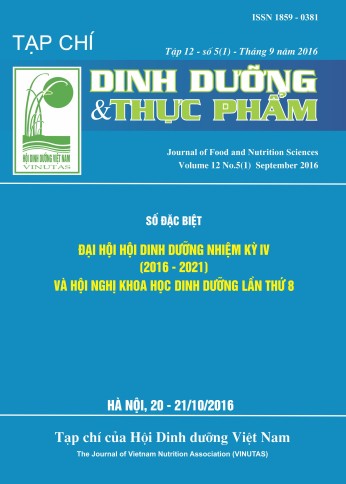NGHIÊN CỨU ẢNH HƯỞNG CỦA CÁC YẾU TỐ CÔNG NGHỆ ĐẾN QUÁ TRÌNH TRÍCH LY LYCOPENE TỪ CÀ CHUA
Nội dung chính của bài viết
Tóm tắt
Lycopene là một hoạt chất sinh học có màu đỏ sáng, thuộc họ carotenoid. Lycopene đã được nhiều nghiên cứu chứng minh là có tác dụng tích cực tới sức khỏe con người, ngăn ngừa một số bệnh tim mạch, bảo vệ cơ thể chống lại một số bệnh ung thư, ngăn chặn tia cực tím gây ra bệnh ban đỏ… Trong nghiên cứu này, lycopene của cà chua đã được trích ly bằng một số loại dung môi trong các điều kiện công nghệ khác nhau. Kết quả cho thấy, điều kiện tối ưu cho quá trình trích ly lycopene từ cà chua là sử dụng dung môi ethyl acetate với tỷ lệ dung môi:nguyên liệu là 3:1; tốc độ khuấy 300 vòng/phút; ở nhiệt độ 500C và trong thời gian 3h. Ở điều kiện này, hàm lượng lycopene và hiệu suất trích ly đạt các giá trị tương ứng là 266,81 mg/l và 86,3%. Trích ly lycopene 2 lần đã nâng hiệu suất trích ly lycopene lên đến 91,3%.
Từ khóa
Lycopene, cà chua, trích ly, dung môi, ethyl acetate
Chi tiết bài viết
Tài liệu tham khảo
2. Nunes I.L., and Mercadante A.Z. (2004). Production of lycopene crystals from tomato waste. Clinical Technology Alimentary Campinas, 24 (3), 440-447.
3. Kumar S.R., Sundar S.S., Afandi A., and Rahman S. (2013). Optimization of lycopene from Malaysian all season coloured fleshy fruits. Inter. Jou of Bio, Phar. And Allied Sci. 2(7), 1455-1467.
4. López Cervantes J., Sanchez-Machado D.I., Valenzuela-Sasnchez K.P., NúñezGastélum J.A., Ana Escárcega-Galaz A., and Roberto Rodríguez-Ramírez. (2014). Effect of solvents and method of stirring in extraction of lycopene, oleoresin and fatty acids from over-ripe tomato, Int. J. Food Sci. Nutr. 65(2), 187-193.
5. Fish W. W., Perkins-Veazie P., and Collins J. K. (2002). A quantitative assay for lycopene that utilizes reduced volumes of organic solvents. Journal of Food Composition and Analysis. 15, 309-317.
6. Strati I.F., and Oreopoulou V. (2011). Process optimization for recovery of carotenoids from tomato waste. Food Chem. 129, 747-52.
7. Mantanis G.I., Young R.A., and Rowell R.M. (1995). Swelling of compressed cellulose fiber webs in organic liquids, Cellulose. 2, 1-22.
8. Nunes I.L., and Mercadante A.Z. (2004). Production of lycopene crystals from tomato waste. Clinical Technology Alimentary Campinas. 24 (3), 440-447.
9. Kadian S.S and Sharma A. (2013). Effect of heat on the stability of tomato extract (lycopene). Inter. Jou of Bio, Phar. And Allied Sci. 2, 386-390.


